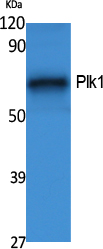Phospho PLK1 (S137) Cell-Based Colorimetric ELISA Kit
- Catalog No.:KA1720C
- Applications:ELISA
- Reactivity:Human;Mouse;Rat
- Gene Name:
- PLK1
- Human Gene Id:
- 5347
- Human Swiss Prot No:
- P53350
- Mouse Swiss Prot No:
- Q07832
- Rat Swiss Prot No:
- Q62673
- Storage Stability:
- 2-8°C/6 months
- Other Name:
- Serine/threonine-protein kinase PLK1 (EC 2.7.11.21) (Polo-like kinase 1) (PLK-1) (Serine/threonine-protein kinase 13) (STPK13)
- Detection Method:
- Colorimetric
- Background:
- catalytic activity:ATP + a protein = ADP + a phosphoprotein.,developmental stage:Accumulates to a maximum during the G2 and M phases, declines to a nearly undetectable level following mitosis and throughout G1 phase, and then begins to accumulate again during S phase.,enzyme regulation:Activated by serine and threonine phosphorylation.,function:Serine/threonine-protein kinase that performs several important functions throughout M phase of the cell cycle, including the regulation of centrosome maturation and spindle assembly, the removal of cohesins from chromosome arms, the inactivation of APC/C inhibitors, and the regulation of mitotic exit and cytokinesis.,induction:By growth-stimulating agents.,PTM:Autophosphorylation and phosphorylation of Ser-137 are not significant events during activation of PLK1 in M phase.,PTM:Catalytic activity is enhanced by phosphorylation of Thr-210 and/or Ser-137.,similarity:Belongs to the protein kinase superfamily.,similarity:Belongs to the protein kinase superfamily. Ser/Thr protein kinase family. CDC5/Polo subfamily.,similarity:Contains 1 protein kinase domain.,similarity:Contains 2 POLO box domains.,subunit:Interacts with CEP170 and EVI5. Interacts and phosphorylates ERCC6L. Interacts with FAM29A.,tissue specificity:Placenta and colon.,
- Function:
- M phase of mitotic cell cycle, mitotic prometaphase, mitotic cell cycle, M phase, nuclear division, cytokinesis, protein amino acid phosphorylation, phosphorus metabolic process, phosphate metabolic process, cell cycle, mitosis, meiosis,female meiosis, cell proliferation, positive regulation of macromolecule metabolic process, phosphorylation, cell cycle process, cell cycle phase, regulation of protein ubiquitination, positive regulation of protein ubiquitination, regulation of protein modification process, positive regulation of protein modification process, regulation of cellular protein metabolic process, positive regulation of cellular protein metabolic process, cytokinesis during cell cycle, cytokinesis after meiosis, polar body extrusion after meiotic divisions, positive regulation of catalytic activity, positive regulation of molecular function, response to antibiotic, organelle f
- Subcellular Location:
- Nucleus. Chromosome, centromere, kinetochore. Cytoplasm, cytoskeleton, microtubule organizing center, centrosome . Cytoplasm, cytoskeleton, spindle . Midbody . localization at the centrosome starts at the G1/S transition (PubMed:24018379). During early stages of mitosis, the phosphorylated form is detected on centrosomes and kinetochores. Localizes to the outer kinetochore. Presence of SGO1 and interaction with the phosphorylated form of BUB1 is required for the kinetochore localization. Localizes onto the central spindle by phosphorylating and docking at midzone proteins KIF20A/MKLP2 and PRC1. Colocalizes with FRY to separating centrosomes and spindle poles from prophase to metaphase in mitosis, but not in other stages of the cell cycle. Localization to the centrosome is required for S ph
- Expression:
- Placenta and colon.
- June 19-2018
- WESTERN IMMUNOBLOTTING PROTOCOL
- June 19-2018
- IMMUNOHISTOCHEMISTRY-PARAFFIN PROTOCOL
- June 19-2018
- IMMUNOFLUORESCENCE PROTOCOL
- September 08-2020
- FLOW-CYTOMEYRT-PROTOCOL
- May 20-2022
- Cell-Based ELISA│解您多样本WB检测之困扰
- July 13-2018
- CELL-BASED-ELISA-PROTOCOL-FOR-ACETYL-PROTEIN
- July 13-2018
- CELL-BASED-ELISA-PROTOCOL-FOR-PHOSPHO-PROTEIN
- July 13-2018
- Antibody-FAQs


